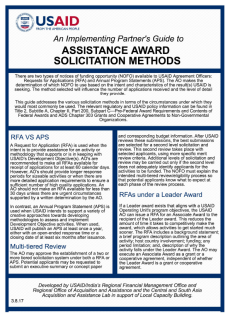There are two types of notices of funding opportunity (NOFO) available to USAID Agreement Officers: Requests for Applications (RFA) and Annual Program Statements (APS). The AO makes the determination of which NOFO to use based on the intent and characteristics of the result(s) USAID is seeking. The method selected will influence the number of applications received and the level of detail they provide.
This guide addresses the various solicitation methods in terms of the circumstances under which they would most commonly be used. The relevant regulatory and USAID policy information can be found in Title 2, Subtitle A, Chapter II, Part 200, Subpart C—Pre-Federal Award Requirements and Contents of Federal Awards and ADS Chapter 303 Grants and Cooperative Agreements to Non-Governmental Organizations.
RFA vs APS
A Request for Application (RFA) is used when the intent is to provide assistance for an activity or methodology that supports or is in keeping with USAID’s Development Objective(s). AO's are recommended to make all RFAs available for receipt of applications for at least 60 calendar days. However, AO's should provide longer response periods for sizeable activities or when there are more detailed application requirements to ensure a sufficient number of high quality applications. An AO should not make an RFA available for less than 30 days unless there are urgent circumstances supported by a written determination by the AO.
In contrast, an Annual Program Statement (APS) is used when USAID intends to support a variety of creative approaches towards developing methodologies to assess and implement Development Objective activities. When used, USAID will publish an APS at least once a year, either with an open-ended response time or a closing date of at least six months after issuance.
Multi-tiered Review
The AO may approve the establishment of a two or more tiered solicitation system under both a RFA or APS. Potential applicants may be requested to submit an executive summary or concept paper and corresponding budget information. After USAID reviews these submissions, the best submissions are selected for a second level solicitation and review. This second review takes place with selected applicants, using more specific merit review criteria. Additional levels of solicitation and review may be carried out only if the second level does not adequately identify applicants for the activities to be funded. The NOFO must explain the intended multi-tiered review/eligibility process so that potential applicants know what to expect at each phase of the review process.
RFAs under a Leader Award
If a Leader award exists that aligns with a USAID Operating Unit's program objectives, the USAID AO can issue a RFA for an Associate Award to the recipient of the Leader award. This reduces the amount of time it takes to competitively make the award, which allows activities to get started much sooner. The RFA includes a background statement; a brief program description outlining the area of activity; host country involvement; funding; any period limitation; and, description of why the activity falls under the Leader Award. The AO may execute an Associate Award as a grant or a cooperative agreement, independent of whether the Leader Award is a grant or cooperative agreement.
3.8.17
Developed by USAID/India’s Regional Financial Management Office and Regional Office of Acquisition and Assistance and the Central and South Asia Acquisition and Assistance Lab in support of Local Capacity Building.

